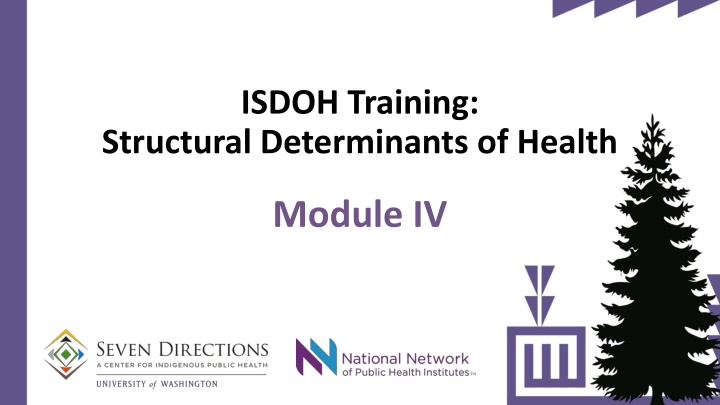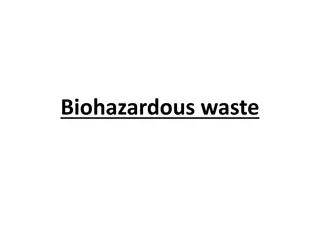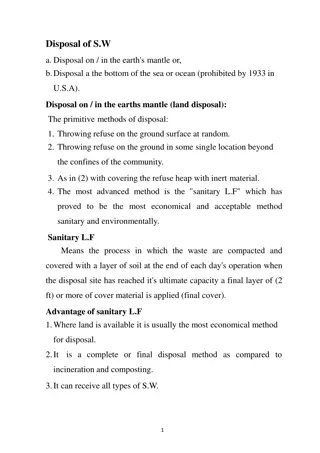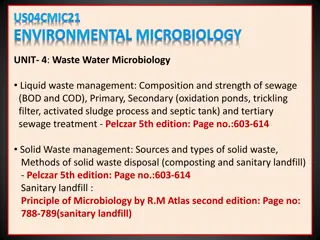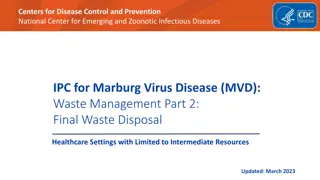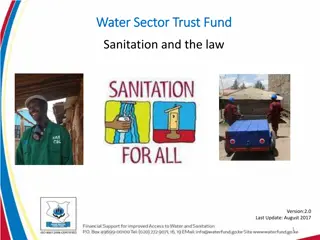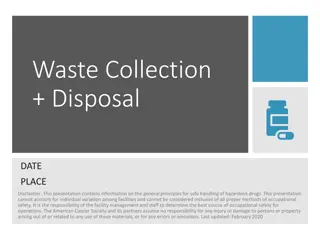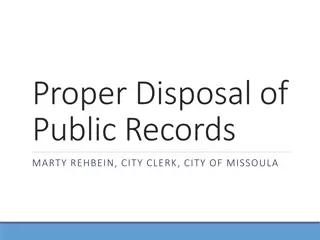Proper Waste Disposal Guidelines
Waste classification, transportation, and disposal according to FAD PReP/NAHEMS Guidelines is crucial for compliance with laws and regulations. Learn about different waste materials, including hazardous and medical waste, and the importance of utilizing professionals for proper waste management. Discover insights on solid waste disposal methods, such as landfill acceptance criteria and restrictions on carcass disposal. Stay informed to ensure environmental and public health safety.
Download Presentation

Please find below an Image/Link to download the presentation.
The content on the website is provided AS IS for your information and personal use only. It may not be sold, licensed, or shared on other websites without obtaining consent from the author.If you encounter any issues during the download, it is possible that the publisher has removed the file from their server.
You are allowed to download the files provided on this website for personal or commercial use, subject to the condition that they are used lawfully. All files are the property of their respective owners.
The content on the website is provided AS IS for your information and personal use only. It may not be sold, licensed, or shared on other websites without obtaining consent from the author.
E N D
Presentation Transcript
ISDOH Training: Structural Determinants of Health Module IV
Purpose and Learning Objectives This module provides definitions of the structural determinants of health within and across tribal and urban Indian communities. At the end of this module, attendees will be able to: Recognize the impact of structural determinants on American Indian and Alaska Native communities. Evaluate the difference and/or connection among structural determinants using case study examples. Define the role that tribal sovereignty and tribal public health governance have on health in American Indian and Alaska Native communities.
Structural Determinants of Health Activity Structural determinants of health include aspects of our lives that operate across communities and regions, such as: Write down an example of each type of structural determinant of health that you see in your community. Share your examples with a partner. Are they similar? Are they different? Take a few minutes to report out to the larger group. (Leung et al., 2022)
Structural Determinants in Indian Country Parker, 2023 American Indian and Alaska Native communities have employed complex systems of governance, health, and social supports since long before European contact (Unal, 2018).
Structural Determinants in Indian Country Before contact, American Indian and Alaska Native practices and belief systems served to support holistic health and well-being. Complex systems, including kinship support, access to nutritionally superior traditional foods, and many other aspects of traditional environments supported health.
Colonial Contact with AIAN Communities Contact with Western European populations had major impacts on American Indian and Alaska Native health. Many Indigenous populations were impacted most by new diseases spread through colonization. Federal and State policies took away access to cultural, linguistic, spiritual, traditional foods, medicines and other key resources important for maintaining health and well-being (Mitchell, 2012; Warne et al., 2019). Despite these forces, American Indians and Alaska Natives have remained resilient and continue to practice traditional ways of life and have adapted practices to strengthen communities.
Historical Trauma Colonization of AIAN communities also resulted in historical trauma, which is: "The cumulative, multigenerational, collective experience of emotional and psychological harm present among American Indian and Alaska Native communities and descendants" (Evans-Campbell, 2008). High levels of: Substance misuse Anxiety Diabetes High blood pressure Depression Post-traumatic stress disorder Cancer Cardiovascular disease can be traced back to the effects of stress, especially toxic stress, and trauma, including historical trauma. (Sebwenna-Painter et al., 2023)
Why are Structural Determinants Frameworks Helpful? As one tribal program director put it, "We aren't responsible for what happened, and yet we are all responsible for healing and moving forward." Areas of improvement could be through tailored policies and prevention program development that improve living conditions, and social, economic, and service environments for AIAN communities.
Tribal Sovereignty: A Tool for Improving Public Health Tribal treaty rights and provisions in federal and state law recognize the political status of American Indians and Alaska Natives. Tribal nations retain all sovereign rights not taken away by Congress. Tribal sovereignty offers opportunities for tribal governments to make their own laws and policies, including those that support public health (Bryan et al., 2009).
Improving Structural Determinants of Health Tribal sovereignty can play an important role in improving structural determinants of health. In urban Indian communities, mutual aid, establishment of non-profit organizations that provide AIAN-tailored social services, and AIAN public health liaisons are some of the ways the 70% of urban AIAN people have developed to improve structural determinants of health for urban AIAN communities. Figure 2: Structural Determinants (Parker, 2023)
Critical Thinking: Applying a Principle of Design to Support Behavior Change at the Tribal System Level Nudging refers to any aspect of the choice architecture that alters people's behavior in a predictable way without forbidding any options or significantly changing their economic incentives . . . Putting the fruit at eye level counts as a nudge. Banning junk food does not. (Thaler & Sunstein, 2008, p. 6, as quoted in Marchiori et al., 2017). The science suggests that humans tend to make quick decisions based on feelings and habits rather than take the time to make logical decisions after reviewing the benefits and costs. How can American Indian and Alaska Native governments incorporate nudges across tribal systems of care?
Critical Thinking: "Nudging" Activity "Nudging" Activity: Refer to Module IV worksheet for activity details Divide into small groups and consider the following questions: Step 1. Consider how diabetes patients access services in your community. What are some important things that help new patients stay on track with diabetes management? What are some critical barriers or challenges that patients face? Make a list of each and map them onto the points in your diagram where they may be an issue. Step 2. What are some key adjustments that could be made to help them stay on the paths they need to adjust to this diagnosis? How could tribal services be adjusted to help nudge them towards a successful diabetes management process? Are there ways to monitor or track how helpful these nudges are to better support patients?
Critical Thinking: "Nudging" Activity Step 3. Make a list of the nudges that could help support patients. What resources would each require to implement? Which ones seem most important and why? Construct a graph or list of the advantages and disadvantages of each nudge. Which one(s) could be implemented by the community? Step 4. Determine how to evaluate the nudges that are adopted. See the Indigenous Evaluation Toolkit in the Resources section, below, for a step-by- step guide to develop an evaluation plan and strategy specific to a particular tribal or urban Indian community.
Post-Module Reflection What were your thoughts about the Structural Determinants of Health and doing the "nudging" exercise? How has your perspective shifted AFTER this module, if at all? How will you apply this information to your current work? Can you identify some things you will do differently after participating in this module?
Summary This module included the background and definitions of the impact of colonization and historical trauma within AIAN communities. Examples of structural determinants of AIAN health were reviewed, along with opportunities to strengthen these determinants. We discussed the "nudge" approach to understand where support for behavioral change can be most effective. Module V will examine systemic determinants of health in tribal and urban Indian communities and how "nudging" may support behavior change.
Resource Indigenous Evaluation Toolkit for Tribal Public Health Programs Eakins, D., Gaffney, A., Marum, C., Wangmo, T., Parker, M. Magarati, M. (Feb. 2023). Indigenous Evaluation Toolkit for Tribal Public Health Programs: An Actionable Guide for Organizations Serving American Indian/Alaska Native Communities through Opioid Prevention Programming. 7D-Indigenous Evaluation-Toolkit-For-Prevention- Programs.pdf
Bibliography Bryan, R. T., Schaefer, R. M., DeBruyn, L., & Stier, D. D. (2009). Public health legal preparedness in Indian Country. American Journal of Public Health (1971), 99(4), 607 614. https://doi.org/10.2105/AJPH.2008.146522 Evans-Campbell, T. (2008). Historical Trauma in American Indian/Native Alaska Communities: A multilevel framework for exploring impacts on individuals, families, and communities. Journal of Interpersonal Violence, 23(3), 316 338. https://doi.org/10.1177/0886260507312290 Leung, J., McMorrow, L., BeLue, R., & Baker, E. A. (2022). Structural and health system determinants of health outcomes in systemic lupus erythematosus: Understanding the mechanisms underlying health disparities. Frontiers in Public Health, 10, 980731 980731. https://doi.org/10.3389/fpubh.2022.980731 Marchiori, D. R., Adriaanse, M. A., & De Ridder, D. T. D. (2017). Unresolved questions in nudging research: Putting the psychology back in nudging. Social and Personality Psychology Compass, 11(1). https://doi.org/10.1111/spc3.12297 Mitchell, F. M. (2012). Reframing Diabetes in American Indian Communities: A Social Determinants of Health perspective. Health & Social Work, 37(2), 71 79. https://doi.org/10.1093/hsw/hls013 Sebwenna-Painter, K., Beckstein, A., & Kraus, S. (2023). Psychological impacts of historic loss and current events surrounding American Indian Boarding Schools. American Indian and Alaska Native Mental Health Research, 30(2), 1 21. https://doi.org/10.5820/aian.3002.2023.1 Unal, D. (2018). Sovereignty and social justice: how the concepts affect federal American Indian policy and American Indian health. Social Work in Public Health, 33(4), 259 270. https://doi.org/10.1080/19371918.2018.1462287 Warne, D., & Wescott, S. (2019). Social Determinants of American Indian Nutritional Health. Current Developments in Nutrition, 3(Supplement_2), 12 18. https://doi.org/10.1093/cdn/nzz054 Thaler, R. H. & Sunstein, C. R. (2008). Nudge: Improving decisions about health, wellness, and happiness. Yale University Press.
Citation Parker, M., Largo, D., Benally, T., Or , C.E. (2023). Indigenous social determinants of health: training modules. University of Washington: Seven Directions. [link to website pdf]
Acknowledgments This project is supported by the Centers for Disease Control and Prevention (CDC) of the U.S. Department of Health and Human Services (HHS) as part of a financial assistance award to the National Network of Public Health Institutes (NNPHI) totaling $375,000 with 100 percent funded by CDC/HHS (Award #s 1 NU38OT000303-01-00, 5 NU38OT000303-04-00, and 5 NU38OT000303-03-00). NNPHI has collaborated with Seven Directions at the University of Washington, and the CDC s Office of Tribal Affairs and Strategic Alliances, on this effort.
